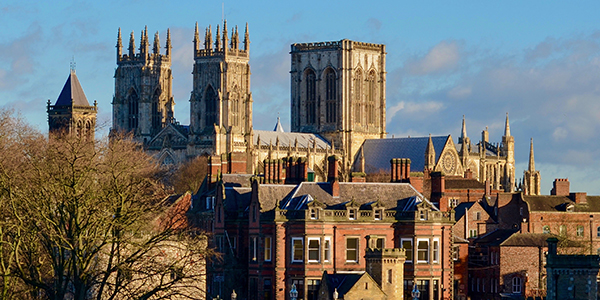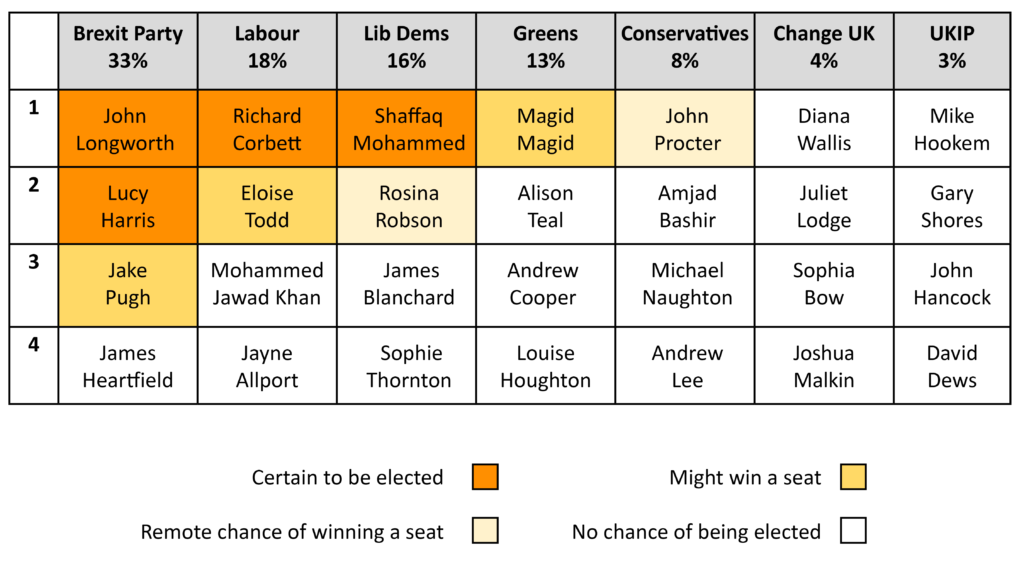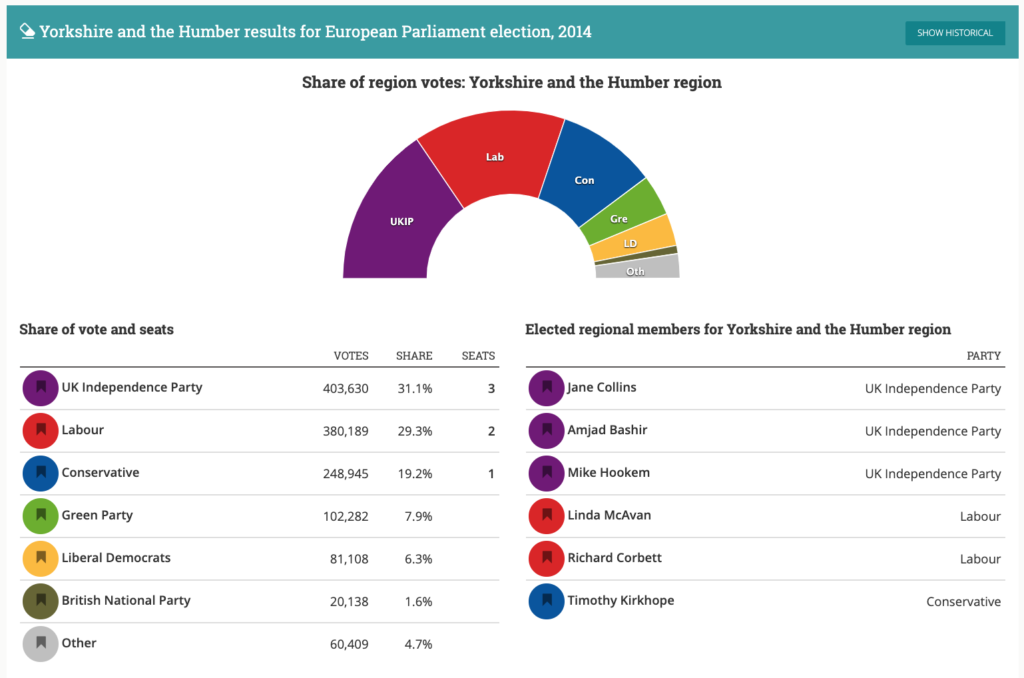European elections 2019: what will happen in Yorkshire and the Humber?
Despite the region’s reputation as a Labour heartland in Westminster politics, at the last European Parliament elections UKIP came a clear first here, winning three of its six seats. That vote has switched now to the Brexit Party, who look likely to achieve the same feat. Labour, the Liberal Democrats and Greens are all strong contenders for one seat each. With voters able to cast only a single vote for a party list in this PR election, which takes place tomorrow, 23 May, the Democratic Audit team reviews the likely outcomes for the parties and looks at who the potentially electable candidates are.

York Minster. Picture: Andy Falconer on Unsplash
Large urban areas such as Leeds, Bradford, Halifax, Sheffield, Doncaster and Hull dominate this region in population terms, and make it most of the time a solidly Labour region. But the Conservatives have historically been strong in the rural north of Yorkshire. In the 2017 general election, Labour gained 49% of the vote regionally and 37 of the 54 seats in Westminster, while the Conservatives won 17 seats on 41% of the vote. But in the 2014 European Parliament elections UKIP’s purple tide gave them 31% support, above Labour on 29%, and enough of a margin to give UKIP three MEPs to Labour’s two. The Conservatives won the other seat on 19%, with no other parties in serious contention.
This year the threshold for winning a seat is a still likely to be around 10–12%, and the Brexit Party on 33% support in the latest regional poll by YouGov (carried out between 8 and 17 May) seems to have comprehensively absorbed UKIP’s past support. They are certain to win two seats, and are very likely to gain three – depending on how exactly the remaining vote share is split between the other parties.
The latest polling suggests that the combined Labor–Conservative two-party vote share has slumped to barely a quarter of the total, and this trend is likely to diversify who wins the remaining seats. On 18% Labour are still second, but far below their general election level, and showing a considerable slide even from their 2014 result of 29%. The prominent Remainer, Richard Corbett, is still certain to be returned as an MEP at the head of Labour’s list, but the party will struggle to retain the second of its existing seats. However, a ComRes poll earlier in May gave Labour a stronger 29%, and only if their core support holds up quite a bit better than YouGov suggest, they would have a chance to keep two MEPs.
Reflecting the national picture, the Liberal Democrats are up to third place with 16% support according to YouGov (compared to just 6% and fifth place in 2014). They would be certain to win a seat on this basis, but unless there is a lot of further movement to strong Remainer parties they cannot do more than that. In fourth place the Greens are also gaining electoral strength, led in Yorkshire and the Humber by the high-profile Sheffield Lord Mayor and activist, Magid Magid. Their current poll share of 13% should be enough for him to gain a seat.
Meanwhile, the Conservatives have slid to just 8% support in the latest polls (down from a third-placed 19% in 2014). At this level they have only a borderline chance of getting the region’s last seat. Unless Tory support on polling day itself proves a lot more resilient, the Brexit Party will gain a third seat, leaving the Conservatives with no MEPs.
The third of the strong Remainer parties, Change UK, has apparently lost out decisively to the Lib Dems and Greens. They are on 4% here, putting them out of contention. Finally, trailing far behind, UKIP are polling just 3%.
These main parties all feature six candidates on the ballot papers, but the lowest ranked candidates in each party list cannot possibly win a seat under a proportional electoral system. Accordingly we show only the top four of them in Figure 1. (For a full candidate list of all parties and independents see here.) On the ballot paper, voters must select just one party list to endorse by casting an X vote for it; they cannot choose individual candidates. In making up their minds which party list to support, voters need only pay attention to the candidates with some chance of winning, those in the colour-shaded boxes below.
Figure 1: Main party candidates and possible winners from YouGov polling in mid-May, for the Yorkshire and the Humber region (six seats)

Polling data YouGov published 19 May (fieldwork 8–17 May).
To find details of all the local candidates, and to locate your polling station, visit our Democratic Dashboard site and simply put in your postcode. The site also has full details of other recent elections in your local area.
Below we list a summary of any candidate in Figure 1 with some chance of being elected, and point to their social media sites, which can show you something of what each candidate is like as a person. At the bottom of this article we also give the full 2014 results for Yorkshire and the Humber.
Which candidates could be elected in Yorkshire and the Humber in 2019?
BREXIT PARTY – The Brexit Party is a clear frontrunner here, as elsewhere. Two seats are certain to go their way on current polling, and a third is a very good prospect.
- John Longworth (Twitter: @john4brexit) is former Director General of the British Chambers of Commerce (2011–16), who left in the run-up to the referendum so he could speak independently during the campaign. He has since been a frequent media commentator on Brexit, and is co-chair of campaign group ‘Leave means Leave’. You can read why he is standing here.
- Lucy Harris (Twitter: @Lugey6) has become a prominent Brexit campaigner since the referendum, founding a group called ‘Leavers of London’, which has since expanded to ‘Leavers of Britain’. Previously she trained as a classical singer, and worked in publishing and communications.
- Jake Pugh (Twitter: @jake_pugh) is a self-employed financial services advisor on business strategy and transformation. He stood as a candidate in Richmond Park for the Referendum Party two decades ago in the 1997 general election. You can find his personal website here.
LABOUR – Richard Corbett has moved to the top of Labour’s list, after his former colleague previously at number 1 (Linda McAvan) stood down. This is lucky for him, because Labour can only be sure of winning one seat, and on current polling would narrowly lose their other one.
- Richard Corbett (Twitter: @RCorbettMEP has been an MEP for the region since 2014, and before that between 1999 and 2009. He is currently Leader of the Labour Party in the European Parliament, and a strong supporter of a second referendum. For his voting record in the EU Parliament, see his Votewatch.eu profile here.
- Eloise Todd (Twitter: @eloisetodd) is a high-profile figure in anti-Brexit campaigns, and is currently on leave from her job as CEO of campaign group ‘Best for Britain’. Set up just before the 2017 general election, it campaigns for a second referendum and to stop Brexit. Previously she worked in Brussels for the anti-poverty campaign ‘ONE’.
LIBERAL DEMOCRATS look assured of one seat in recent polls, reflecting their renaissance here as home for the strong-Remain vote. A second seat looks out of reach, unless a further large influx of support occurs.
- Shaffaq Mohammed (Twitter: @shaffaqmohd) is leader of the Lib Dem group on Sheffield city council, and is a youth worker. You can read his profile here.
- Rosina Robson (Twitter: @RosinaRobson) has worked for several trade associations and formerly worked for the Foreign Office. She previously stood as a candidate for the Lib Dems in the 2017 general election in Uxbridge and South Ruislip.
GREEN PARTY – With a well-known, media-savvy Sheffield politician leading their list, and improved recent polling, the Greens now have a good chance of picking up a seat here.
- Magid Magid (Twitter: @MagicMagid) is a Sheffield councillor who has just come to the end of his year-long term as Lord Mayor of Sheffield (the youngest ever). He was born in Somalia and came to the UK as a refugee. He regularly speaks in support of immigration and against racism. You can read his candidacy pitch here.
CONSERVATIVES – On current polling the Conservatives are on the cusp of having no seats, with the region’s last seat likely to go to the Brexit Party. They could retain an MEP only if their support on the day is well above what the polls say.
- John Procter (Twitter: @JProcterMEP) is the sitting MEP, although back in 2014 he was only third on the Conservatives’ candidate list (and so not elected). In September 2016 Proctor took over when the Tory MEP elected in 2014 (Timothy Kirkhope) was made a peer in David Cameron’s resignation honours list. For his voting record in Brussels see his Votewatch.eu profile here. He was previously Deputy Leader of the Conservative group on Leeds council.
CHANGE UK have faded into also-rans here with only 4% poll ratings, despite putting a high-profile former MEP and campaigner for Yorkshire devolution top of their list.
- Diana Wallis (Twitter: @dianapwallis) was previously a Liberal Democrat MEP for this region between 2004 and 2012, when she stood down. She subsequently stood as a candidate for the Yorkshire Party in several general elections, before joining Change UK. She has also worked in law and academia and her profile is here.
UKIP also has no real chance of winning any seats here, despite fielding one of the very few incumbent UKIP MEPs who have stuck with the party (rather than defecting).
- Mike Hookem (Twitter: @mikehookemmep) was (just) elected as UKIP’s MEP in 2014. You can see his Votewatch.eu profile and parliamentary voting record here. He is now deputy leader of the party under Gerard Batten.
Figure 2: 2014 European Parliament results in Yorkshire and the Humber

Source: Democratic Dashboard. Order elected and current status: 1. Jane Collins (resigned from UKIP April 2019, now joined the Brexit Party); 2 Linda McAvan (Labour); 3. Timothy Kirkhope (Conservative, replaced by John Procter); 4. Amjad Bashir (elected as UKIP, but left to join the Conservativee); 5. Richard Corbett (Labour); 6. Mike Hookem (UKIP).
Read more about how the European Parliament elections work:





 Democratic Audit's core funding is provided by the Joseph Rowntree Charitable Trust. Additional funding is provided by the London School of Economics.
Democratic Audit's core funding is provided by the Joseph Rowntree Charitable Trust. Additional funding is provided by the London School of Economics.